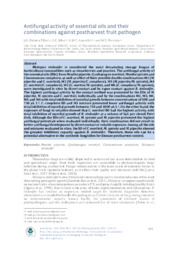Antifungal activity of essential oils and their combinations against postharvest fruit pathogen.
Antifungal activity of essential oils and their combinations against postharvest fruit pathogen.
Autoria: OLIVEIRA FILHO, J. G.; SILVA, G. C.; AZEREDO, H. M. C. de; FERREIRA, M. D.
Resumo: ABSTRACT: Rhizopus stolonifer is considered the most devastating storage fungus of horticultural commodities such as strawberries and peaches. The antifungal activity of the essential oils (EOs) from Mentha piperita, Cymbopogon martinii, Mentha spicata and Cinnamomum camphora, as well as effect of their possible double combinations M1 (M. piperita and C. martinii), M2 (M. piperita/C. camphora), M3 (M. piperita/M. spicata), M4 (C. martinii/C. camphora), M5 (C. martini/M. spicata), and M6 (C. camphora/M. spicata), were investigated in vitro by direct contact and by vapor contact against R. stolonifer. The highest antifungal activity by the contact method was promoted by the EOs of M. piperita, M. spicata and C. martinii, individually, and by the combinations M2, M3, M4, M5 and M6 with total inhibition of mycelial growth between concentrations of 500 and 750 μL L-1. C. camphora EO and M1 mixture presented lower antifungal activity with total inhibition of mycelial growth between 750 and 1000 μL L-1. On the other hand, the exposure of fungi to volatiles showed that C. martinii EO had the highest activity, with total inhibition of mycelial growth of R. stolonifer at a volume of 5μL per closed Petri dish. Although the EOs of C. martinii, M. spicata and M. piperita presented the highest antifungal potentials when evaluated individually, their combination did not result in better antifungal development by direct contact or volatile exposure. Among all the oils and mixtures evaluated in vitro, the EO of C. martinii, M. spicata and M. piperita showed the greatest inhibitory capacity against R. stolonifer. Therefore, these oils can be a potential alternative to the synthetic fungicides for disease postharvest control.
Ano de publicação: 2021
Tipo de publicação: Artigo de periódico
Unidade: Embrapa Agroindústria Tropical
Palavras-chave: Cinnamomum camphora, Cymbopogon martinii, Mentha Piperita, Rhizopus stolonifer
Observações
1 - Por padrão são exibidas publicações dos últimos 20 anos. Para encontrar publicações mais antigas, configure o filtro ano de publicação, colocando o ano a partir do qual você deseja encontrar publicações. O filtro está na coluna da esquerda na busca acima.
2 - Para ler algumas publicações da Embrapa (apenas as que estão em formato ePub), é necessário ter, no celular ou computador, um desses softwares gratuitos. Sistemas Android: Google Play Livros; IOS: iBooks; Windows e Linux: software Calibre.
Acesse outras publicações
Acesse a Base de Dados da Pesquisa Agropecuária (BDPA) para consultar o acervo completo das bibliotecas da Embrapa.

